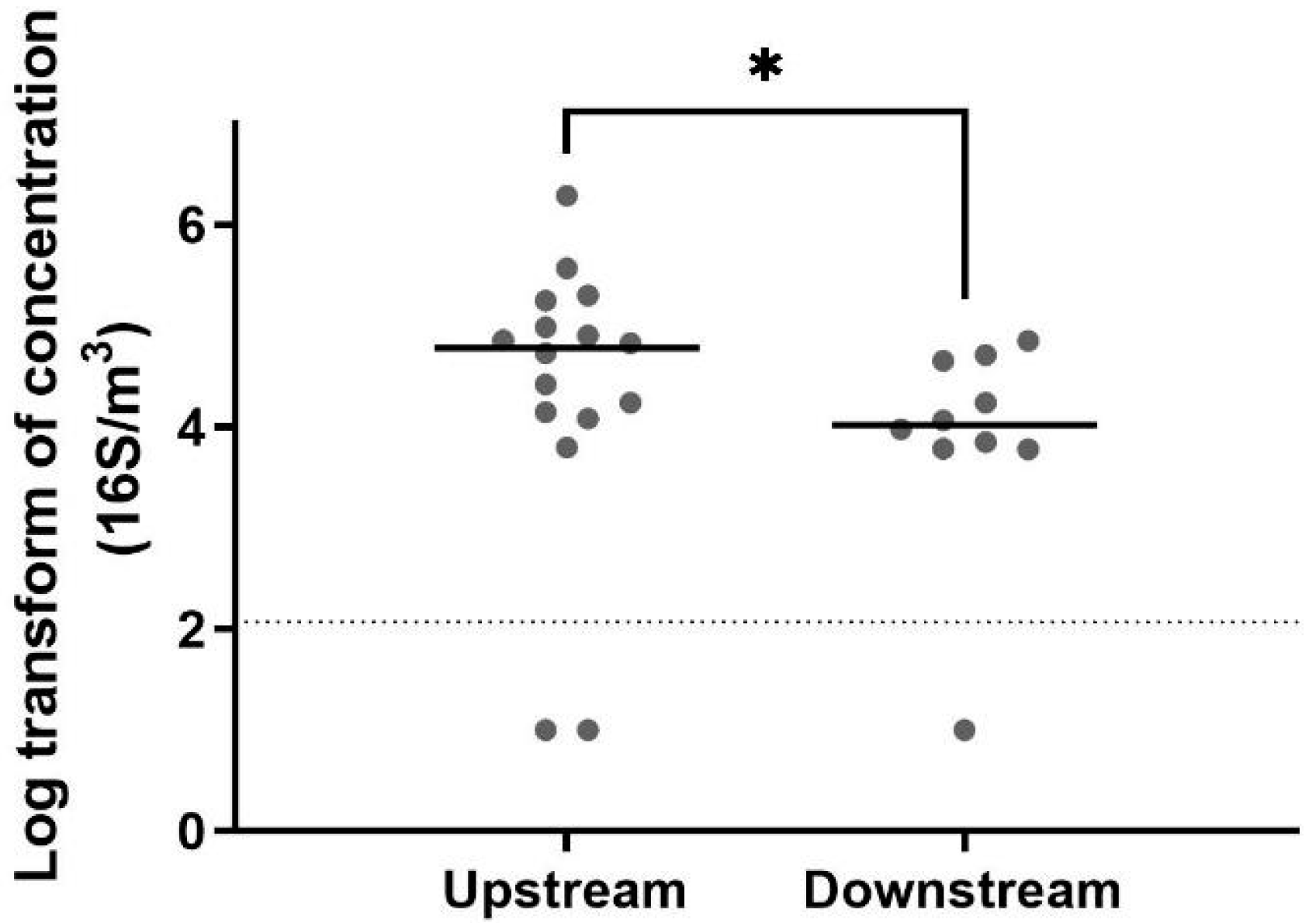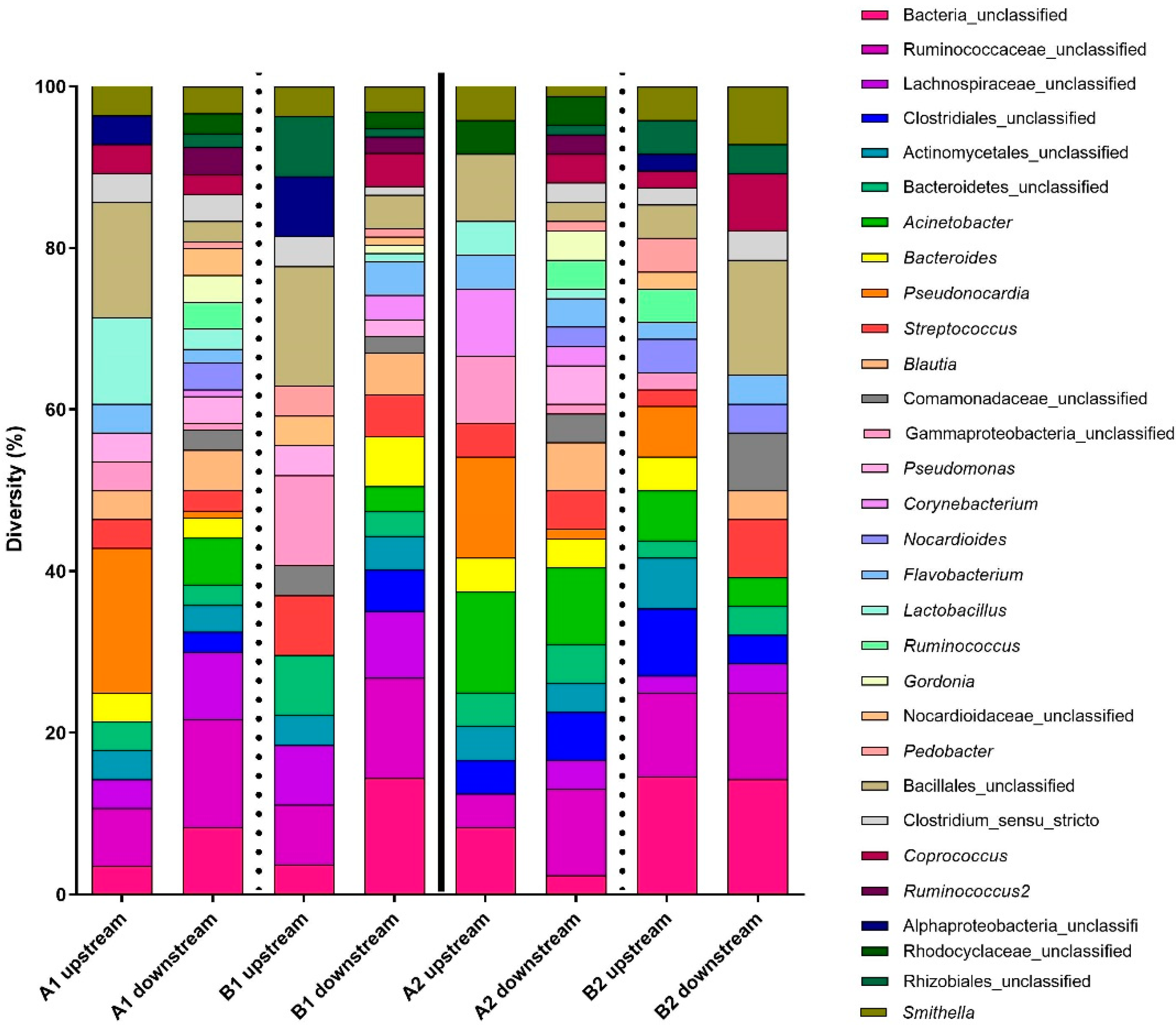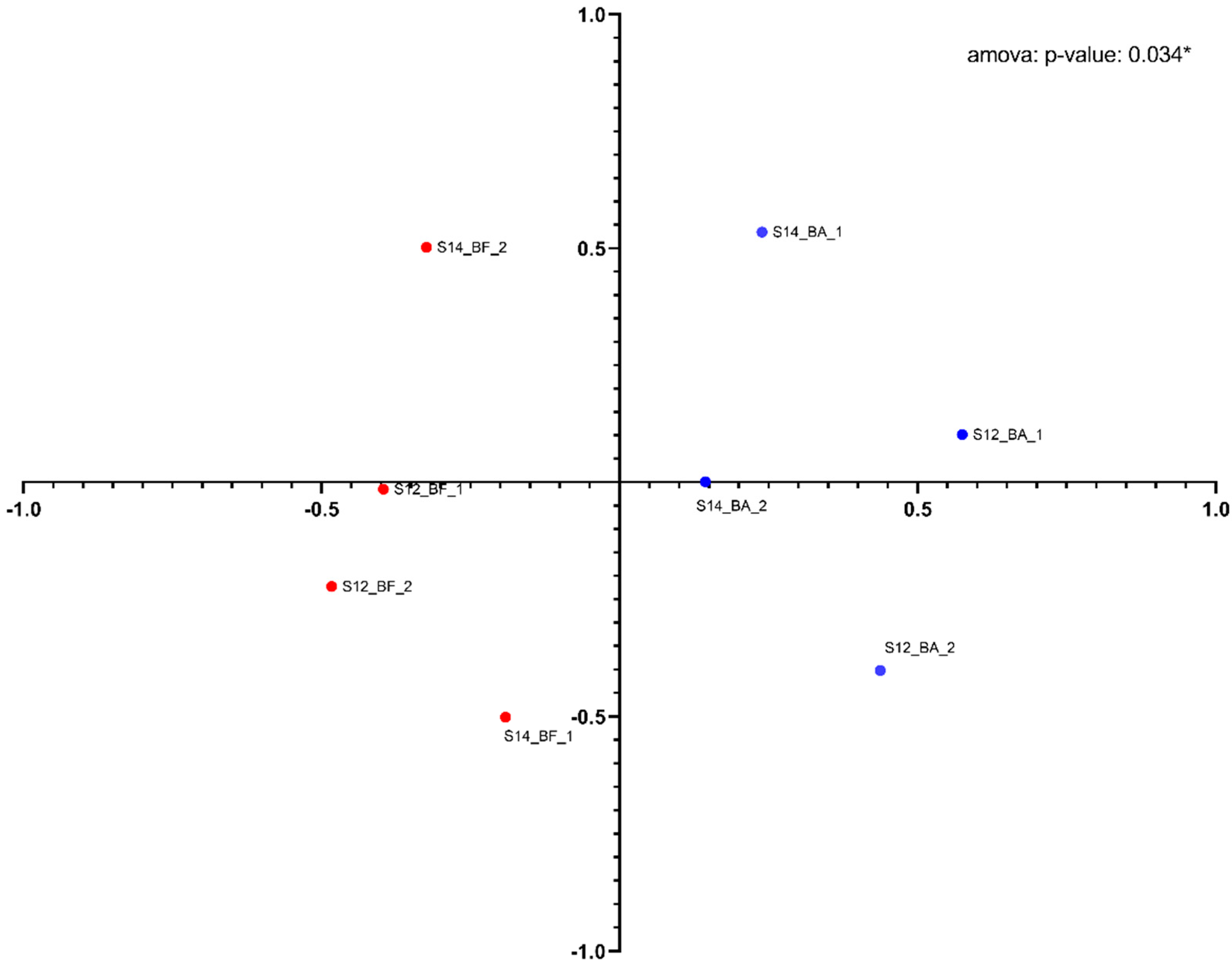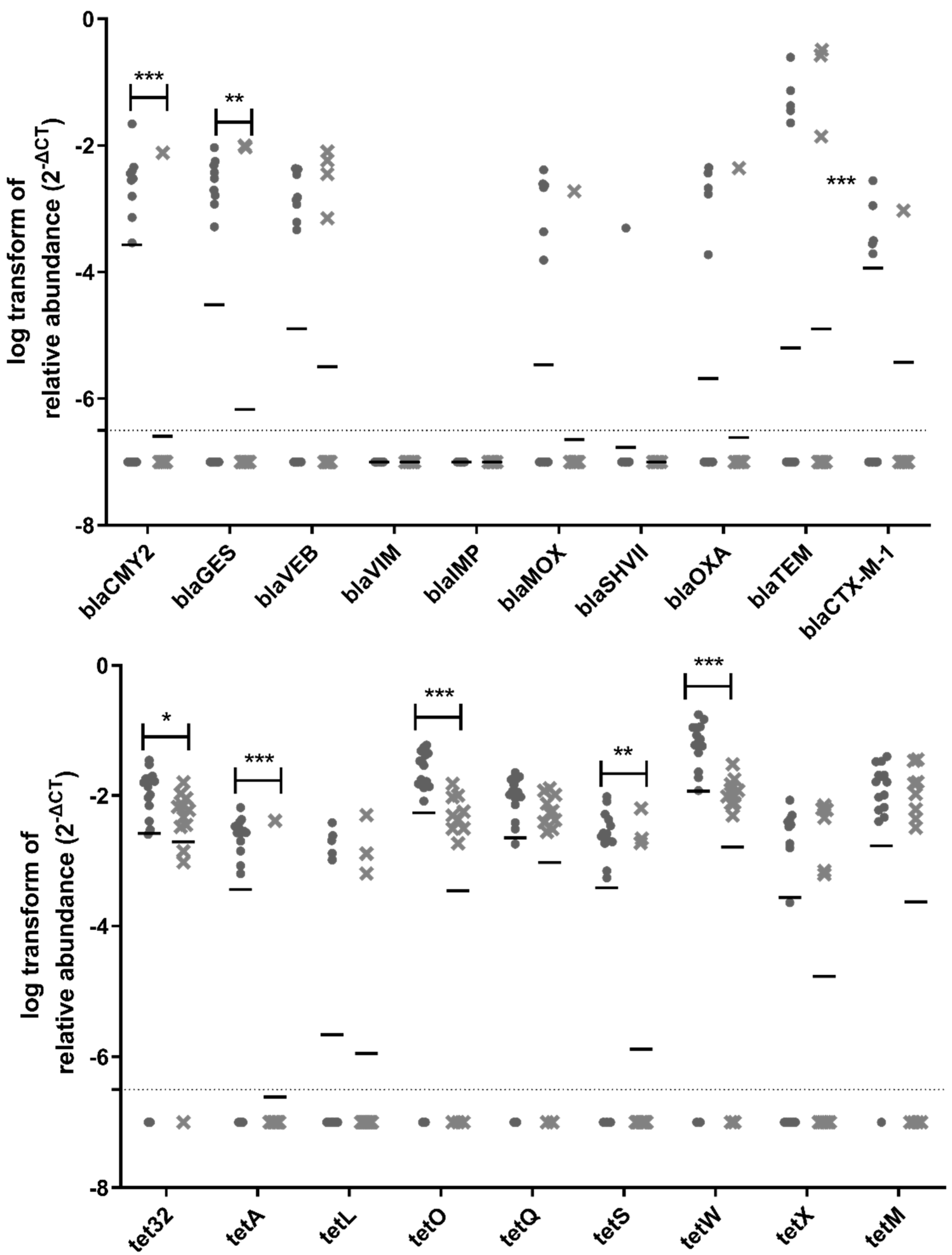Effect of Odor-Treatment Biofilter on Bioaerosols from an Indoor Wastewater Treatment Plant
Abstract
1. Introduction
2. Materials and Methods
2.1. Sampling Site
2.2. Air Sampling
2.3. DNA Extraction
2.4. Real-Time Quantitative Polymerase Chain Reaction of Total Bacteria, ARGs and Legionella Pneumophila
2.5. 16S Sequencing
2.6. Data Analysis for the Presence of ARGs
3. Results and Discussion
3.1. Concentration and Diversity of Bioaerosols
3.2. Presence of Taxa Associated with Opportunistic Pathogens
3.3. Impact of Odor Biofiltration System on ARGs and MGEs
4. Conclusions
Supplementary Materials
Author Contributions
Funding
Institutional Review Board Statement
Informed Consent Statement
Data Availability Statement
Acknowledgments
Conflicts of Interest
References
- Moreno-Mesonero, L.; Ferrús, M.A.; Moreno, Y. Determination of the bacterial microbiome of free-living amoebae isolated from wastewater by 16S rRNA amplicon-based sequencing. Environ. Res. 2020, 190, 109987. [Google Scholar] [CrossRef] [PubMed]
- Brisebois, E.; Veillette, M.; Dupont, V.D.; Lavoie, J.; Corbeil, J.; Culley, A.; Duchaine, C. Human viral pathogens are pervasive in wastewater treatment center aerosols. J. Environ. Sci. 2017, 67, 45–63. [Google Scholar] [CrossRef] [PubMed]
- Sanchez-Monedero, M.A.; Aguilar, M.I.; Fenoll, R.; Roig, A. Effect of the aeration system on the levels of airborne microorganisms generated at wastewater treatment plants. Water Res. 2008, 42, 3739–3744. [Google Scholar] [CrossRef]
- Karkman, A.D.T.; Walsh, F.; Virta, M.P.J. Antibiotic-Resistance Genes in Waste Water. Trends Microbiol. 2018, 26, 220–228. [Google Scholar] [CrossRef]
- Amos, G.C.H.P.; Gaze, W.H.; Wellington, E.M. Waste water effluent contributes to the dissemination of CTX-M-15 in the natural environment. J. Antimicrob. Chemother. 2014, 69, 1785–1791. [Google Scholar] [CrossRef] [PubMed]
- Marti, E.J.J.; Balcazar, J.L. Prevalence of antibiotic resistance genes and bacterial community composition in a river infuenced by a wastewater treatment plant. PLoS ONE 2013, 8, e78906. [Google Scholar] [CrossRef] [PubMed]
- World Health Organization. Global Action Plan on Antimicrobial Resistance. 2015. Available online: https://ahpsr.who.int/publications/i/item/global-action-plan-on-antimicrobial-resistance (accessed on 14 December 2021).
- World Health Organization. Global Priority List of Antibiotic-Resistant Bacteria to Guide Research, Discovery, and Development of New Antibiotics. 2017. Available online: https://www.who.int/news/item/27-02-2017-who-publishes-list-of-bacteria-for-which-new-antibiotics-are-urgently-needed (accessed on 14 December 2021).
- Li, J.; Zhou, L.; Zhang, X.; Xu, C.; Dong, L.; Maosheng, Y. Bioaerosol emissions and detection of airborne antibiotic resistance genes from wastewater treatment plant. Atmos. Environment. 2016, 124, 404–412. [Google Scholar] [CrossRef]
- Mbareche, H.; Veillette, M.; Dion-Dupont, V.; Lavoie, J.; Duchaine, C. Microbial composition of bioaerosols in indoor wastewater treatment plants. Aerobiologia 2022, 38, 35–50. [Google Scholar] [CrossRef]
- Thorn, J.; Kerekes, E. Health effects among employees in sewage treatment plants: A literature survey. Am. J. Ind. Med. 2001, 40, 170–179. [Google Scholar] [CrossRef]
- Fannin, K.F.; Vana, S.C.; Jakubowski, W. Effect of an Activated Sludge Wastewater Treatment Plant on Ambient Air Densities of Aerosols Containing Bacteria and Viruses. Appl. Environ. Microbiol. 1985, 49, 1191–1196. [Google Scholar] [CrossRef]
- Reinthaler, F.F.; Posch, J.; Feierl, G.; Wust, G.; Haas, D.; Ruckenbauer, G.; Mascher, F.; Marth, E. Antibiotic resistance of E. coli in sewage and sludge. Water Res. 2003, 37, 1685–1690. [Google Scholar] [CrossRef]
- Han, Y.; Yang, T.; Xu, G.; Li, L.; Liu, J. Characteristics and interactions of bioaerosol microorganisms from wastewater treatment plants. J. Hazard. Mater. 2020, 391, 12256. [Google Scholar] [CrossRef] [PubMed]
- Loenenbach, A.D.; Beulens, C.; Euser, S.M.; van Leuken, J.P.G.; Bom, B.; van der Hoek, W.; de Roda Husman, A.M.; Ruijs, W.L.M.; Bartels, A.A.; Rietveld, A.; et al. Two Community Clusters of Legionnaires’ Disease Directly Linked to a Biologic Wastewater Treatment Plant, the Netherlands. Emerg. Infect. Dis. 2018, 24, 1914–1918. [Google Scholar] [CrossRef] [PubMed]
- Brissaud, F.; Blin, E.; Hemous, S.; Garrelly, L. Water reuse for urban landscape irrigation: Aspersion and health related regulations. Water Sci. Technol. 2008, 57, 781–787. [Google Scholar] [CrossRef]
- Caicedo, C.; Beutel, S.; Scheper, T.; Rosenwinkel, K.H.; Nogueira, R. Occurrence of Legionella in wastewater treatment plants linked to wastewater characteristics. Environ. Sci. Pollut. Res. 2016, 23, 16873–16881. [Google Scholar] [CrossRef]
- Kulkarni, P.; Olson, N.D.; Paulson, J.N.; Pop, M.; Maddox, C.; Claye, E.; Goldstein, R.E.R.; Sharma, M.; Gibbs, S.G.; Mongodin, E.F.; et al. Conventional wastewater treatment and reuse site practices modify bacterial community structure but do not eliminate some opportunistic pathogens in reclaimed water. Sci. Total Environ. 2018, 639, 1126–1137. [Google Scholar] [CrossRef]
- Lund, V.; Fonahn, W.; Pettersen, J.E.; Caugant, D.A.; Ask, E.; Nysaeter, Å. Detection of Legionella by cultivation and quantitative real-time polymerase chain reaction in biological waste water treatment plants in Norway. J. Water Health 2014, 12, 543–554. [Google Scholar] [CrossRef]
- Radomski, N.; Betelli, L.; Moilleron, R.; Haenn, S.; Moulin, L.; Cambau, E.; Rocher, V.; Gonçalves, A.; Lucas, F.S. Mycobacterium Behavior in Wastewater Treatment Plant, A Bacterial Model Distinct From Escherichia coli and Enterococci. Environ. Sci. Technol. 2011, 45, 5380–5386. [Google Scholar] [CrossRef]
- Swanson, W.J.; Loehr, R.C. Biofiltration: Fundamentals, Design and Operations Principles, and Applications. J. Environ. Eng. 1997, 123, 538–546. [Google Scholar] [CrossRef]
- Estrada, J.M.; Kraakman, N.B.; Muñoz, R.; Lebrero, R. A comparative analysis of odour treatment technologies in wastewater treatment plants. Environ. Sci. Technol. 2011, 45, 1100–1106. [Google Scholar] [CrossRef]
- Oprime, M.E.A.G.; Garcia, O., Jr.; Cardoso, A.A. Oxidation of H2S in acid solution by Thiobacillus ferrooxidans and Thiobacillus thiooxidans. Process Biochem. 2001, 37, 111–114. [Google Scholar] [CrossRef]
- Burgess, J.E.; Parsons, S.A.; Stuetz, R.M. Developments in odour control and waste gas treatment biotechnology: A review. Biotechnol. Adv. 2001, 19, 35–63. [Google Scholar] [CrossRef]
- Sonil, N.; Prakash, K.S.; Jayanthi, A. Microbial biofiltration technology for odour abatement: An introductory review. J. Soil Sci. Environ. Manag. 2012, 3, 28–35. [Google Scholar] [CrossRef][Green Version]
- Mbareche, H.; Veillette, M.; Bilodeau, G.J.; Duchaine, C. Bioaerosol sampler choice should consider efficiency and ability of samplers to cover microbial diversity. Appl. Environ. Microbiol. 2018, 84, e01589-18. [Google Scholar] [CrossRef]
- Bach, H.J.; Tomanova, J.; Schloter, M.; Munch, J.C. Enumeration of total bacteria and bacteria with genes for proteolytic activity in pure cultures and in environmental samples by quantitative PCR mediated amplification. J. Microbiol. Methods 2002, 49, 235–245. [Google Scholar] [CrossRef]
- Stedtfeld, R.D.; Guo, X.; Stedtfeld, T.M.; Sheng, H.; Williams, M.R.; Hauschild, K.; Gunturu, S.; Tift, L.; Fang, W.; Howe, A.; et al. Primer set 2.0 for highly parallel qPCR array targeting antibiotic resistance genes and mobile genetic elements. FEMS Microbiol. Ecol. 2018, 94, fiy130. [Google Scholar] [CrossRef]
- Blatny, J.M.; Reif, B.A.P.; Skogan, G.; Andreassen, O.; Høiby, E.A.; Ask, E.; Waagen, V.; Aanonsen, D.; Aaberge, I.S.; Caugant, D.A. Tracking Airborne Legionella and Legionella pneumophila at a Biological Treatment Plant. Environ. Sci. Technol. 2008, 42, 7360–7367. [Google Scholar] [CrossRef]
- Veillette, M.; Bonifait, L.; Mbareche, H.; Marchand, G.; Duchaine, C. Preferential aerosolization of Actinobacteria during handling of composting organic matter. J. Aerosol Sci. 2018, 116, 83–91. [Google Scholar] [CrossRef]
- Schloss, P.D. A high-throughput DNA sequence aligner for microbial ecology studies. PLoS ONE 2009, 4, e8230. [Google Scholar] [CrossRef]
- Schloss, P.D. Reintroducing mothur: 10 years later. Appl. Environ. Microbiol. 2020, 86, e02343-19. [Google Scholar] [CrossRef]
- Brunner, E.; Domhof, S.; Langer, F. Nonparametric Analysis of Longitudinal Data in Factorial Experiments. Biometrics 2002, 54, 1040. [Google Scholar] [CrossRef]
- Paranjape, K.; Bédard, E.; Whyte, L.G.; Ronholm, J.; Prévost, M.; Faucher, S.P. Presence of Legionella spp. in cooling towers: The role of microbial diversity, Pseudomonas, and continuous chlorine application. Water Res. 2020, 169, 115252. [Google Scholar] [CrossRef] [PubMed]
- Ranalli, G.; Zanardini, E.; Sorlini, C. Biodeterioration—Including Cultural Heritage. In Encyclopedia of Microbiology, 3rd ed.; Academic Press: Cambridge, MA, USA, 2009; pp. 191–205. [Google Scholar] [CrossRef]
- Goris, T.; Diekert, G. The Genus Sulfurospirillum. In Organohalide-Respiring Bacteria; Adrian, L., Löffler, F., Eds.; Springer: Berlin/Heidelberg, Germany, 2016. [Google Scholar] [CrossRef]
- Kodama, Y.; Watanabe, K. Sulfuricurvum kujiense gen. nov., sp. nov., a facultatively anaerobic, chemolithoautotrophic, sul-fur-oxidizing bacterium isolated from an underground crude-oil storage cavity. Int. J. Syst. Evol. Microbiol. 2004, 54, 2297–2300. [Google Scholar] [CrossRef] [PubMed]
- Imhoff, J.F. Chromatiales ord. nov. In Bergey’s Manual of Systematic Bacteriology, 2nd ed.; Springer: New York, NY, USA, 2005; Volume 2 (The Proteobacteria), part B (The Gammaproteobacteria), pp. 1–3. [Google Scholar] [CrossRef]
- Storelli, N.; Peduzzi, S.; Saad, M.M.; Frigaard, N.U.; Perret, X.; Tonolla, M. CO2 Assim Chemocline Lake Cadagno is dominated by a few types of phototrophic purple sulfur bacteria. FEMS Microbiol. Ecol. 2013, 84, 421–432. [Google Scholar] [CrossRef]
- Carducci, A.; Tozzi, E.; Rubulotta, E.; Casini, B.; Cantiani, L.; Rovini, E.; Muscillo, M.; Pacini, R. Assessing airborne biological hazard from urban wastewater treatment. Water Res. 2000, 34, 1173–1178. [Google Scholar] [CrossRef]
- Valster, R.M.; Wullings, B.A.; Bakker, G.; Smidt, H.; van der Kooij, D. Free-Living Protozoa in Two Unchlorinated Drinking Water Supplies, identified by Phylogenic Analysis of 18S rRNA Gene Sequences. Appl. Environ. Microbiol. 2009, 75, 4736–4746. [Google Scholar] [CrossRef][Green Version]
- Haig, S.J.; Kotlarz, N.; LiPuma, J.J.; Raskin, L. A High-Throughput Approach for Identification of Nontuberculous Mycobacteria in Drinking Water Reveal Relationship between Water Age and Mycobacterium avium. Am. Soc. Microbiol. 2018, 9, e02354-17. [Google Scholar] [CrossRef]
- Gupta, R.S.; Lo, B.; Son, J. Phylogenomics and Comparative Genomic Studies Robustly Support Division of the Genus Mycobacteriuminto an Emended Genus Mycobacterium and Four Novel Genera. Front. Microbiol. 2018, 9, 1–41. [Google Scholar] [CrossRef]
- Falkinham, J.O., III. Mycobacterial aerosols and respiratory disease. Emerg. Infect. Dis. 2003, 9, 763–767. [Google Scholar] [CrossRef]
- Parker, B.C.; Ford, M.A.; Gruft, H.; Falkinham, J.O., 3rd. Epidemiology of infection by nontuberculous mycobacteria. IV. Preferential aerosolization of Mycobacterium intracellu-lare from natural water. Am. Rev. Respir. Dis. 1983, 128, 652–656. [Google Scholar] [CrossRef]
- Wendt, S.L.; George, K.L.; Parker, B.C.; Gruft, H.; Falkinham, J.O., 3rd. Epidemiology of infection by nontuberculous mycobacteria. III. Isolation of potentially pathogenic mycobacteria in aerosols. Am. Rev. Respir. Dis. 1980, 122, 259–263. [Google Scholar] [CrossRef] [PubMed]
- Han, Y.; Yang, T.; Yan, X.; Li, L.; Liu, J. Effect of aeration mode on aerosol characteristics from the same wastewater treatment plant. Water Res. 2020, 170, 115324. [Google Scholar] [CrossRef] [PubMed]
- Michaud, J.M.; Thompson, L.R.; Kaul, D.; Espinoza, J.L.; Richter, R.A.; Xu, Z.Z.; Lee, C.; Pham, K.M.; Beall, C.M.; Malfatti, F.; et al. Taxon-specific aerosolization of bacteria and viruses in an experimental ocean-atmosphere mesocosm. Nat. Commun. 2018, 9, 1–10. [Google Scholar] [CrossRef] [PubMed]
- Hendriksen, R.S.; Munk, P.; Njage, P.; van Bunnik, B.; McNally, L.; Lukjancenko, O.; Röder, T.; Nieuwenhuijse, D.; Pedersen, S.K.; Kjeldgaard, J.; et al. Global monitoring of antimicrobial resistance based on metagenomics analyses of urban sewage. Nat. Commun. 2019, 10, 1124. [Google Scholar] [CrossRef]
- Triggiano, F.; Calia, C.; Diella, G.; Montagna, M.T.; De Giglio, O.; Caggiano, G. The Role of Urban Wastewater in the Environmental Transmission of Antimicrobial Resistance: The Current Situation in Italy (2010–2019). Microorganisms 2020, 8, 1567. [Google Scholar] [CrossRef]
- Government of Canada. 2020 Veterinary Antimicrobial Sales Highlights Report. 2020. Available online: https://www.canada.ca/en/health-canada/services/publications/drugs-health-products/2020-veterinary-antimicrobial-sales-highlights-report.html (accessed on 12 September 2022).
- Zhang, A.N.; Gaston, J.M.; Dai, C.L.; Zhao, S.; Poyet, M.; Groussin, M.; Yin, X.; Li, L.G.; van Loosdrecht, M.C.M.; Topp, E.; et al. An omics-based framework for assessing the health risk of antimicrobial resistance genes. Nat. Commun. 2021, 12, 4765. [Google Scholar] [CrossRef]
- Fortin, E.; Quach, C.; Dionne, M.; Irace-Cima, A.; Sirois, C.; Simard, M.; Jean, S.; Magali-Ufitinema, N. Impact des Maladies Chroniques sur les Taux D’utilisation des Antibiotiques dans la Communauté; Institut National de Santé Publique du Québec: Québec, QC, Canada, 2022. [Google Scholar]
- Nnadozie, C.F.; Kumari, S.; Bux, F. Status of pathogens, antibiotic resistance genes and antibiotic residues in wastewater treatment systems. Rev. Environ. Sci. Bio/Technol. 2017, 16, 491–515. [Google Scholar] [CrossRef]







| Upstream | OTU | % | Downstream | OTU | % |
|---|---|---|---|---|---|
| Bacillales_unclassified | 12 | 1.76 | Ruminococcaceae_unclassified | 40 | 2.55 |
| Bacteria_unclassified | 11 | 1.61 | Bacteria_unclassified | 30 | 1.91 |
| Pseudonocardia | 11 | 1.61 | Lachnospiraceae_unclassified | 22 | 1.40 |
| Ruminococcaceae_unclassified | 10 | 1.47 | Acinetobacter | 19 | 1.21 |
| Gammaproteobacteria_unclassified | 7 | 1.03 | Blautia | 17 | 1.08 |
| Actinomycetales_unclassified | 6 | 0.88 | Streptococcus | 14 | 0.89 |
| Acinetobacter | 6 | 0.88 | Clostridiales_unclassified | 14 | 0.89 |
| Bacteroidetes_unclassified | 5 | 0.73 | Bacillales_unclassified | 13 | 0.83 |
| Streptococcus | 5 | 0.73 | Bacteroides | 12 | 0.76 |
| Smithella | 5 | 0.73 | Coprococcus | 12 | 0.76 |
Publisher’s Note: MDPI stays neutral with regard to jurisdictional claims in published maps and institutional affiliations. |
© 2022 by the authors. Licensee MDPI, Basel, Switzerland. This article is an open access article distributed under the terms and conditions of the Creative Commons Attribution (CC BY) license (https://creativecommons.org/licenses/by/4.0/).
Share and Cite
Bélanger Cayouette, A.; Ouradou, A.; Veillette, M.; Turgeon, N.; George, P.B.L.; Corbin, S.; Boulanger, C.; Duchaine, C.; Bédard, E. Effect of Odor-Treatment Biofilter on Bioaerosols from an Indoor Wastewater Treatment Plant. Atmosphere 2022, 13, 1723. https://doi.org/10.3390/atmos13101723
Bélanger Cayouette A, Ouradou A, Veillette M, Turgeon N, George PBL, Corbin S, Boulanger C, Duchaine C, Bédard E. Effect of Odor-Treatment Biofilter on Bioaerosols from an Indoor Wastewater Treatment Plant. Atmosphere. 2022; 13(10):1723. https://doi.org/10.3390/atmos13101723
Chicago/Turabian StyleBélanger Cayouette, Amélia, Arthur Ouradou, Marc Veillette, Nathalie Turgeon, Paul B. L. George, Stéphane Corbin, Christian Boulanger, Caroline Duchaine, and Emilie Bédard. 2022. "Effect of Odor-Treatment Biofilter on Bioaerosols from an Indoor Wastewater Treatment Plant" Atmosphere 13, no. 10: 1723. https://doi.org/10.3390/atmos13101723
APA StyleBélanger Cayouette, A., Ouradou, A., Veillette, M., Turgeon, N., George, P. B. L., Corbin, S., Boulanger, C., Duchaine, C., & Bédard, E. (2022). Effect of Odor-Treatment Biofilter on Bioaerosols from an Indoor Wastewater Treatment Plant. Atmosphere, 13(10), 1723. https://doi.org/10.3390/atmos13101723







